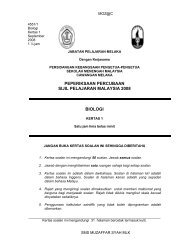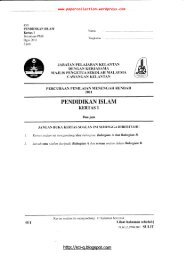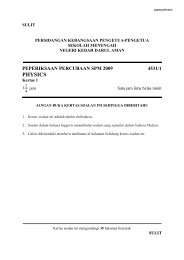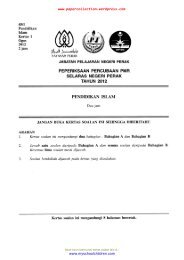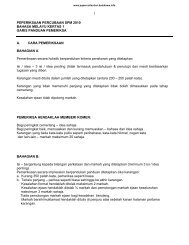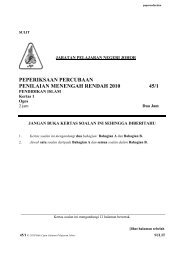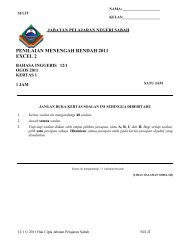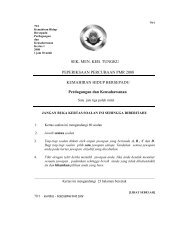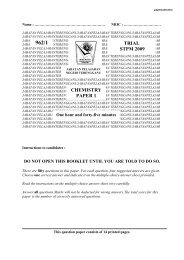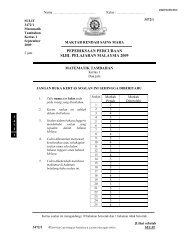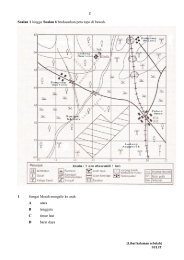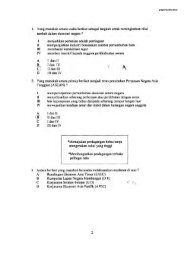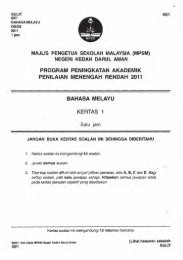Answers For Physics Paper 1 Trial 2010 1. C 6. A 11.B 16. A 21. C ...
Answers For Physics Paper 1 Trial 2010 1. C 6. A 11.B 16. A 21. C ...
Answers For Physics Paper 1 Trial 2010 1. C 6. A 11.B 16. A 21. C ...
- No tags were found...
Create successful ePaper yourself
Turn your PDF publications into a flip-book with our unique Google optimized e-Paper software.
www.papercollection.batukawa.infoQuestion 4 Answer Note(a)(i) 1 Thermionic emission(a)(ii) 1 To accelerate electrons(b) 1 Kinetic energy heat energy + light energy(c)(i) 1 Alternating current/ AC(c)(ii) 1 Period, T = 3 0.02s = 0.06 sWith correct unit1 F=1/T = 1/0.06s = 1<strong>6.</strong>67 Hz(d) 10.01s / div4V / divTotal: 7 marksQuestion 5 Answer Note(a) 1 Atmospheric pressure/ Air pressure(b)(i) 1 The volume of air trapped in the beaker diagram 5.1 is larger Quantities must be(b)(ii) 1 The pressure of air trapped in the beaker diagram 5.2 is bigger(c)(i) 1 The higher the pressure, the lower the volume of air trapped(c)(ii) 1 Boyle’s law(d) 111Density of air > waterWater exerts upthrustUpthrust > Weight of beaker + air trappedTotal : 8 markssame as stated inquestions.
www.papercollection.batukawa.infoSection BQuestion 9 Answer Note(a)(i) 1 Refraction(a)(ii) 1 Ratio of sin i / sin r // The ratio of speed of light in vacuumrelative to that speed through a medium(b) 1111(c)1Refractive index of the glass is higher.The density of glass is higherThe angle of refraction of light ray in glass is shorterThe higher the density of medium, the smaller the angle ofrefraction of light.The higher the density of medium, the higher the refractiveindex.Light refractedaway from normal– 1 mExtrapolation toshow position ofthe observingimage – 1 m(d)(i)- He must shoot the target at the lower position of the image.1- mObjective lensTotal internalreflection45454545Total internalreflectionEyepiece
www.papercollection.batukawa.infoDistribution of marks:1 mark - Labeled 90 prism1 mark - Arrangement of prisms --- facing each other1 mark - Location of objective lens1 mark - Location of the eyepiece lens1 mark - Light ray with 2 times total internal reflection at the 1stprism1 mark - Light ray with 2 times total internal reflection at the 2ndprism(d)(ii)22ModificationsObjective lens with largerdiameter.Eyepiece lens with higherpower // Thicker eyepiecelensReasonsMore light passes throughthe lensAct as a strong magnifyingglassTotal : 20 marksQuestion 10 Answer Note(a) 1 A wave in which the vibration of particles in the medium isparallel to the direction of propagation of the wave(b)(i) 1 The amplitude in Diagram 10.2 is higher(b)(ii) 1 The peak value, a 2 in Diagram 10.2 is higher(b)(iii) 1 The higher the amplitude of vibration of tuning forks, the higherthe peak value(b)(iv) 1 The higher the peak value, the louder the sound(b)(v) 1 The higher the amplitude, the louder the sound(c) 11111- Use ultrasound- Ultrasound is transmitted to the sea bed- a receiver will then detect the reflected the reflected pulses- the time taken by the pulse to travel to the seabed and return tothe receiver being recorded, t- the depth of the sea can be calculated using the formula,vtd 2Max 4 marks
www.papercollection.batukawa.info(d)1111111111SuggestionsLoudspeakers arepositioned at quite adistance away.The two mainloudspeakers are notpositioned opposite toeach otherFix soft boards/wooden/ materialswhich are soundabsorbersUse thick carpet/Wooden floor/ RubberfloorAssemble a high powerspeaker systemReasonSo that the distance betweenconsecutive constructive /destructive interference issmaller.To prevent multiplereflectionsReflection effects can bereducedTo prevent echoTo produce a high amplitudeof sound waveMax 10 marks11Assemble the speaker ata high placeWide coverage // the wave isnot blockedTotal : 20
www.papercollection.batukawa.infoSection CQuestion 11 Answer Note(a)(i) 1 Archimedes’ principle states that the buoyant force on anobject immersed in a fluid is equal to the weight of fluiddisplaced by the object.(a)(ii) 1111(b)1111111111- Volume of air displaced equal to volume of a balloon- Density of air decreased as a altitude increase- Weight of displaced air become smaller- At certain height weight of displaced air equal to weight of theballoonCharacteristicsLarge ballonUse 2 burners // ManyburnersSynthetic nylonExplainationTo produce bigger buoyant/ upthrust // Increase thevolume of the air displacedTo produce bigger flame //heat up the gas in theballoon fasterLight-weight/ strong /airproofmaterialReduce the density /weightof the air in the balloonHigh temperature of the airin the balloonHot air balloon Q is chosen Large balloon, use 2burners / many burners,use synthetic nylon andhas high temperature of theair in the balloon.(c)(i) 1Mass = density x volumeWith correct unit(c)(ii)1111Mass = 0.169 kg m -3 x <strong>1.</strong>2 m 3 = 0.20 kgCalculate mass of displaced air correctlym = <strong>1.</strong>3 kg m -3 x <strong>1.</strong>2 m 3 =<strong>1.</strong>56kgCalculate weight of displaced air correctly and state thatbouyant force equal to weight of displaced airWeight of displaced air = bouyant force= mg = <strong>1.</strong>56 x 10= 15.6NTotal : 20 marksWith correct unit
www.papercollection.batukawa.infoQuestion 12 Answer Note(a) 1 A fuse is a very thin wire, which either melts or vaporizes whentoo much current flows through it(b) 1111- A parallel circuit can run several devices using the full voltageof the supply.- If one device fails, the others will continue running normally- If the device shorts, the other devices will receive no voltage,preventing overload damage.- A failure of one component does not lead to the failure of theother components.- More components may be added in parallel without the needfor more voltage.- Each electrical appliance in the circuit has it own switch.(c)(i) 1 - The electrical appliance use 240 V of voltage to generates 500W of power.(c)(ii) 1 Current = Power/VoltageMax 4 marksWith correct unit1(c)(iii) 11Current = 500/240 = 2.08 AEfficiency = Output Power x 100 %Input PowerOutput Power = 85 x 500100Output power = 425 WWith correct unit(d)CharacteristicsThin fuse wireCeramic cartridgeFuse rating is 13 ALow melting pointR is chosen becauseExplanationLess space needed/ to carry alimited electrical current/ lessmass hence low heatcapacity/ shorter time to heatup to melting point and blow.Can withstand highertemperature because sparkscreated by high voltage,240V can be huge/Maximum rating must behigher than normal current.<strong>For</strong> fast blow/ Melting fasterwhen excessive currentflow/ Easy to cut the currentflow.Because it has thin fuse wire,ceramic cartridge, fuse ratingis 13 A and low meltingpoint.Total : 20 marks
www.papercollection.batukawa.infoMARKING SCHEME PHYSICS PAPER 3 (TRIAL <strong>2010</strong>)No Answer Marks1 a) (i) Distance between 2 coherent sources of sound waves, a 1(ii) Distance between two consecutive instances of loud sound, x 1(iii) Distance between loudspeakers and where soun isb) (i)(ii)detected/frequency of sound waves/ wavelength of sound waves 1a = <strong>1.</strong>0m x = 15.2cma = <strong>1.</strong>5m x = 10.3 cma = 2.0m x = 7.3 cma = 2.5 m x = 5.9 cma = 3.0 m x = 4.7 cmAll correct 2M4 correct 1M3 correct 0M( accept : 0.1 cm)1 / m-1a<strong>1.</strong>000.670.500.400.33x / cm15.210.37.35.94.7x / m3.042.06<strong>1.</strong>46<strong>1.</strong>180.94Tabulate data1<strong>1.</strong> Shows a table which have and x a12. State the correct unit ( : m -1 and x : m)a3. All values x are correct14. Values of are consistent to 2 decimal pointa5. Values of x are consistent to 2 decimal point11111 (7)c)Draw graph x against a1<strong>1.</strong> The responding variable, x at y axis2. The manipulated variable, a1 at x axis3. Sates the unit of variable correctly4. Both axis with the even and uniform scale5. 5 points correctly plotted<strong>6.</strong> A smooth best fit straight line7. Minimum size (50% of graph paper)No of ticks Score7 55-6 43-4 32 21 1 5d) x is inversely propotional to a OR x is directly proportional to 1/a 1TOTAL 161
www.papercollection.batukawa.info1No Answer Marks2 a) Extrapolation on graph to cross y-axis where h=0mCorrect answer with unit<strong>1.</strong>00 x 10 5 Nm -2 11 (2)b) (i)(ii)Large triangle ( 4 x 3 larger square)on graph1Correct substitution (refer to triangle drawn) exp:55(<strong>1.</strong>610) (<strong>1.</strong>010)1k 0.7 0Correct answer with correct unitk = 5999.3 Nm -31 (3)Method with correct substitution refer to answer in (i)10.12 (5.999.3)Correct answer1 (2) = 719.92 kgm -3c) Line on graph at h = 0.5 mP = <strong>1.</strong>043 x 10 5 + <strong>1.</strong>0 x 10 5 Nm -2 OR 2.043 x 10 5 Nm -2Correct substitution OR final answer with unit (accept the valuehalf of small square )1 (2)d) (i) Increase1(ii) The higher the density, the higher the pressure and producethe higher gradient of graph P - h1 (2)e) Describe the method to avoid parallax errorThe eye at the same level of meniscus of water 1TOTAL 123. a) Correct inference refer to actual situation and correct directionThe distance between paper to the lens / focal length is depends onthe thickness of lens. 1b) Correct hypothesis with correct direction (refer to variables thatchoose for the experiment)The higher the thickness of lens, the longer its focal length 1c) i) Aim of the experimentTo Investigate the relationship between the focal length andthe thickness of lens.1ii)iii)Variables (MV and RV should can be measured)MV : The thickness of lensRV : The focal lengthFV : Refractive index of lens / the diameter of lens / type oflensList of apparatus (ruler and vernier caliper/micrometerscrew gauge must be in the list)5 convex lenses of different thickness but samediameter, light box/candle with flame, low voltagepower supply, screen, plasticine, ruler andmicrometer screw gauge/ vernier caliper2111
www.papercollection.batukawa.infoiv)Arrangement of apparatus (Should be relevant andfunctional)to a.cscreen lens with holder ray box (far from thelens as a distance object)v) Procedures<strong>1.</strong> The thickness of lens is measured using the verniercaliper/micrometer screw gauge and record.2. The lens is adjusted until the clear sharp image offilament is obtain on the screen.The distance betweencentre of lens to the screen is measured as the focallength.3. The experiment is repeated use another four differentthickness of lenses. (accept without values because thethickness is unknown and measured before theexperiment)1111NOTES : ACCEPT OTHERS EXPERIMENT THAT RELATETO THE SITUATION SUCH AS<strong>1.</strong> relationship between u and v where f is measure use1 1 1the formula u v f2. use distance object (outside object) to determine thefocal length of lensvi)Show the tableThickness / cmFocal length / cm1vii)State the graph should be drawn or draft the graphDraw a graph, the focal length against the thickness of lensORfocal length / cm1Thickness / cmTotal Marks 124. a) Correct inference refer to actual situation and correct directionThe brightness of lamp depend on the speed of wheel. 1b) Correct hypothesis with correct direction (refer to variables thatchoose for the experiment)The higher the speed of magnet, the higher the current induced 1c) i) Aim of the experimentTo Investigate the relationship between the high ofmagnet and the current induced. 13
www.papercollection.batukawa.infoii)iii)iv)v)Variables (MV and RV should can be measured)MV : Speed (of the magnet)RV : current (induced)FV : Numbers of turns of the coil / the diameter of coil / thethickness of wireList of apparatus (ruler and galvanometer must be in thelist)coil/selonoid made of copper wire, ruler , galvanometer andconnecting wireArrangement of apparatus (Should be relevant andfunctional)1111hGProcedures<strong>1.</strong> The apparatus is set up as the diagram shown.2. The strong magnet is released at 10 cm of height.3. The division of the galvanometer’s pointer deflect isrecorded.4. The experiment is repeated at the height of magnet is15cm, 20 cm, 25 cm and 30 cm111vi)Show the tableheight / cmdivision1vii)State the graph should be drawn or draft the graphDraw a graph, the division against the height of magnetreleased1ORdivisionheight / cmTotal Marks 124



